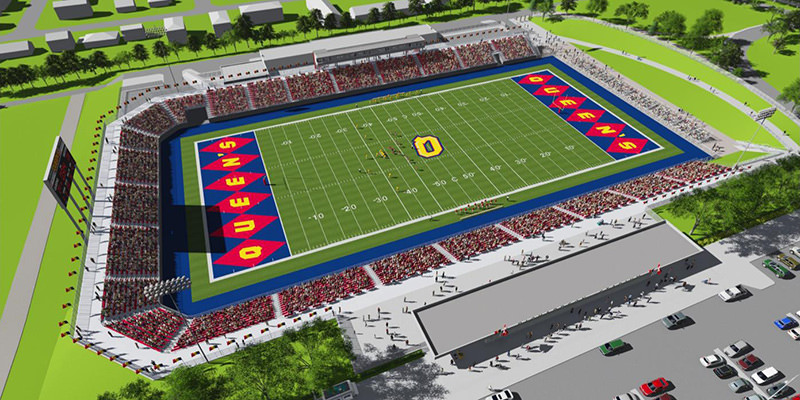
A rendering of what the new George Richardson Stadium might look like, from the east looking west.
Photo Credit: http://www.queensu.ca
By CLAUDE SCILLEY
Construction will begin on a new stadium at Queen’s University immediately after the 2015 football season, the university announced Monday.
“It’s a good first step,” said Paul Hand, who, with his wife, Vicki, is co-chair of a subcommittee working to raise money for outdoor athletic facilities, including a structure to replace decrepit Richardson Stadium.
The $20.27 million stadium is planned to be ready for the 2016 Ontario University Athletics season.
A drawing on the university’s website shows a facility with a single tier of stands with seating for about 9,000—that’s slightly less than what the old stadium accommodated—in a horseshoe configuration on the west, south and east sides, looking not unlike the old Varsity Stadium in Toronto. The new stadium, actually Richardson III, will be built on the site of the current field, slightly to the east of the current structure. The press box will remain on the west side, but the scoreboard will be at the south end.
Initially, the drawings show, there will be an open concourse to the north, but eventually that will be the site of a pavillion. Step 2, as Hand called it, will house permanent dressing rooms, offices for coaches, training rooms and an athletic therapy clinic, once an additional $15 million is raised.
To date, $17 million has been raised for Phase 1 of the project, an artificial turf field and the stands. The major benefactors are football alumnus Stu Lang, who ponied up $10 million to launch the campaign, and the Richardson Foundation—administered by the family of the man for whom the stadium was named—which pledged $5 million. The university has earmarked about $3 million to re-route roads and re-position parking lots.
The original George Richardson Memorial Stadium was located on the main campus, on the south side of Union Street where Tindall Field and Mackintosh-Corry Hall are now located. In 1972 the current stadium was erected on west campus, between Yonge Street and Sir John A. Macdonald Boulevard, south of Johnson Street, as a temporary facility, using some of the wooden seating planks and structural steel from the original edifice.
In the summer of 2013, engineers condemned the upper tiers of seating on both the east and west sides of the stadium as unsafe. The upper stands on the east—student—side of the field were removed and temporary stands installed. The upper stands on the west—alumni—side were cordoned off.
Approval to proceed was granted by the trustees on the weekend.
“At least we’ll have a facility to play in,” Hand said. “Hopefully we won’t have too many upsets with the local consultation process and we can get the architects going on the final drawings, and get all the permits from the city, so we’ll be ready to roll (at the end of next season).
“We’re anxious to get going because, as you know, it’s in pretty tough shape.”
Hand is confident that the current stadium can be demolished and a new one built in a nine-month period that includes a Canadian winter.
“We’ve had the construction guys (involved), and they think that if it was approved at the December board meeting, and it was, we can get right on to the final drawings, final plan, permitting with the city, and the consultation process … presuming the last game is late October, early November, can start right away.
“It’s not a complex project. It isn’t like you’re taking down a huge building. There’s infrastructure to be dealt with, and then the field itself has to be torn up, proper drainage (installed). They’re fairly optimistic that if they get started at the end of the season, plus or minus a couple of weeks, they can make an August time frame.”
With $15 million to raise for the pavillion, Hand is mindful that his committee’s work is not done.
“There’s more to do but you never know where your next benefactor is going to come from,” he said. “You spread the word and some day someone thinks it’s something they’d like to be involved with.
“It’s been a long time coming. For some of us patience is a virtue and … you have to be patient because what you think is dear to you is not dear to other people. It’s big money and the fifties and hundreds and participation is nice, but the reality is it comes from a very few people who will write the big cheques. It takes a while. It has to be from someone who thinks it’s important to them, and there’s lots of competing needs in the world.”

